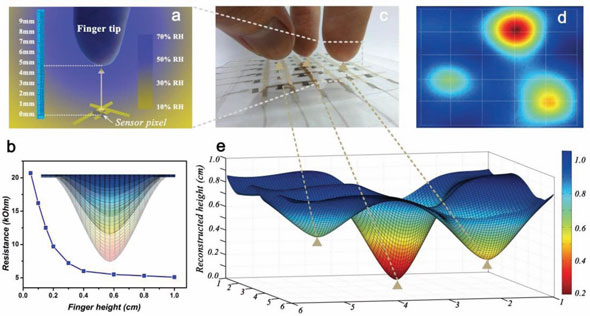| Posted: Jul 03, 2012 | |
Move over touchscreen - here comes a touchless interface that senses your fingertips |
|
| (Nanowerk Spotlight) Over the past few years, touchscreens have become ubiquitous in the world of mobile electronic devices. A next generation of touch sensing devices will be vastly more advanced and lead to ultrasensitive artificial skins (see for instance: "New artificial skin could make prosthetic limbs and robots more sensitive"). Another, novel model for advanced man-machine interactive systems could be based on moisture detectors. Here, actual touch is no longer necessary for a positioning interface to react; rather, the distribution of water molecules that exists around all humid surfaces, such as a human finger, would be sufficient to trigger a response. | |
| "The sensitivity of moisture responsiveness usually relies on the interval structures of the grain boundaries, as well as the electropositivity of exposed metal atoms, which greatly influence the electrical response triggered by the moisture stimuli," explains Yi Xie, a professor at the University of Science and Technology of China. "And thus, ultrathin nanosheets could provide an ideal platform for ultrasensitive moisture responsive devices, in that the 2D planar structures with large specific surface area could largely enrich the number of edge-exposed atoms and active intervals to absorb water molecules." | |
| "Besides" adds Xie, "as a critical factor for moisture responsiveness, the electropositivity of central metal ion should be, though has rarely been, taken into consideration for rational selection of moisture responsive materials in 2D platforms." | |
| Reporting their findings in a recent edition of Advanced Materials ("Giant Moisture Responsiveness of VS2 Ultrathin Nanosheets for Novel Touchless Positioning Interface"), Xie and her collaborators demonstrate a flexible touchless positioning interface based on the spatial mapping of moisture distribution. | |
| In order to achieve high sensitivity and flexibility of the sensing pixels, the team developed ultrathin nanosheets of vanadium disulfide (VS2). They point out that VS2 nanosheets with a quasi 2D electronic structure is a very promising material for high moisture responsiveness. | |
 |
|
| (a) The schematics of RH distribution on the near surface of a finger tip. (b) Height-resolved resistance diagram on the near surface of a finger tip measured by the as-established humidity sensor. Inset is the colored illustration of the surface humidity gradient of the finger. (c) The digital photograph of the relative positions of three finger tips above the 6 x 6 matrix. (d) Top-viewed 2D signal intensity distribution measured from the sensor matrix by an electronic analyzer. (e) Side-viewed 3D mapping of the relative positions of the applied three finger tips, showing successful 3D positioning function. (Reprinted with permission from Wiley-VCH Verlag) | |
| In previous work, Xie and her team already developed a technique to exfoliate bulk VS2 flakes into ultrathin VS2 nanosheets stacked with less than five S-V-S single layers – representing a brand new two-dimensional material having metallic behavior aside from graphene (see paper in JACS: "Metallic Few-Layered VS2 Ultrathin Nanosheets: High Two-Dimensional Conductivity for In-Plane Supercapacitors"). | |
| Now, in this new work, the team takes advantage of the high-performance moisture detection of VS2 thin film by fabricating a novel proof-of-concept fully flexible device: a 3D positioning interface via spatial mapping of moisture distribution. | |
| As the researchers point out, "the preparation of transferable thin films with desirable orientation is an indispensable prerequisite to make use of the microscopic planar electric properties of nanosheets, and is actually a challenge from the practical point of view." | |
| Interestingly, when being evaporated or suction filtrated, the VS2 nanosheets solution would restack into a c-oriented assembly structure, from which a highly oriented thin film of VS2 ultrathin nanosheets could then be obtained. | |
| "In our experiments, we discovered that the electric conductivity of this oriented film was highly sensitive to environmental humidity, which has a resistance change of almost two orders of magnitude from the relative humidity of 0% to that of 100%," explains Xie. "Our pulse-stimuli experiments also showed the fast responsiveness and short recovery time of the sensor, both of which are important performance parameters for advanced electronic applications." | |
| An intriguing feature of this touchless positioning interface is that it not only localizes the 2D position of an applied humid pointer – like a finger tip – but it can also detect the relative height information as the third dimensionality. | |
| Assuming that these devices could be manufactured at a low cost and high reliability, they could well facilitate a next-generation man-machine interactive interface. | |
 By
Michael
Berger
– Michael is author of three books by the Royal Society of Chemistry:
Nano-Society: Pushing the Boundaries of Technology,
Nanotechnology: The Future is Tiny, and
Nanoengineering: The Skills and Tools Making Technology Invisible
Copyright ©
Nanowerk LLC
By
Michael
Berger
– Michael is author of three books by the Royal Society of Chemistry:
Nano-Society: Pushing the Boundaries of Technology,
Nanotechnology: The Future is Tiny, and
Nanoengineering: The Skills and Tools Making Technology Invisible
Copyright ©
Nanowerk LLC
|
|
|
Become a Spotlight guest author! Join our large and growing group of guest contributors. Have you just published a scientific paper or have other exciting developments to share with the nanotechnology community? Here is how to publish on nanowerk.com. |
|
